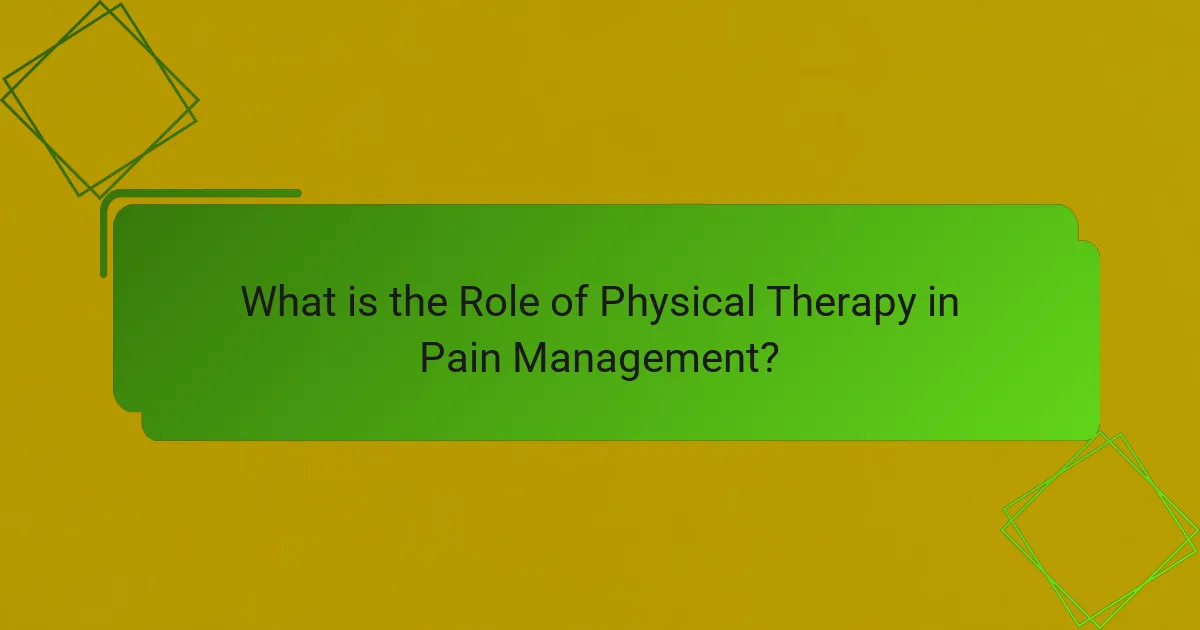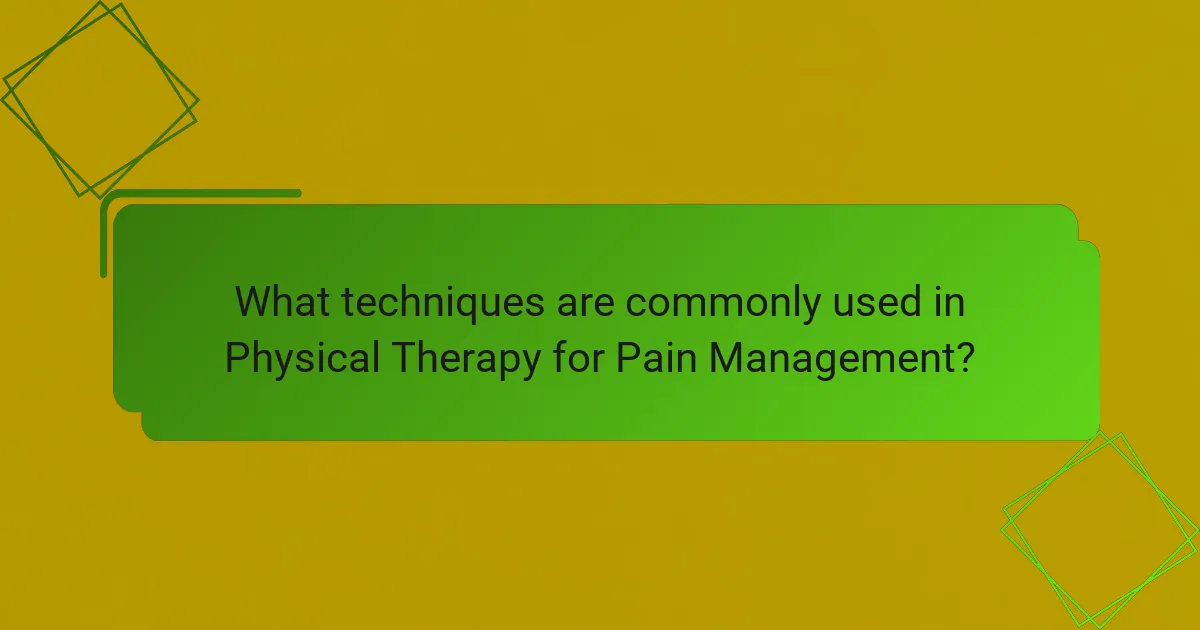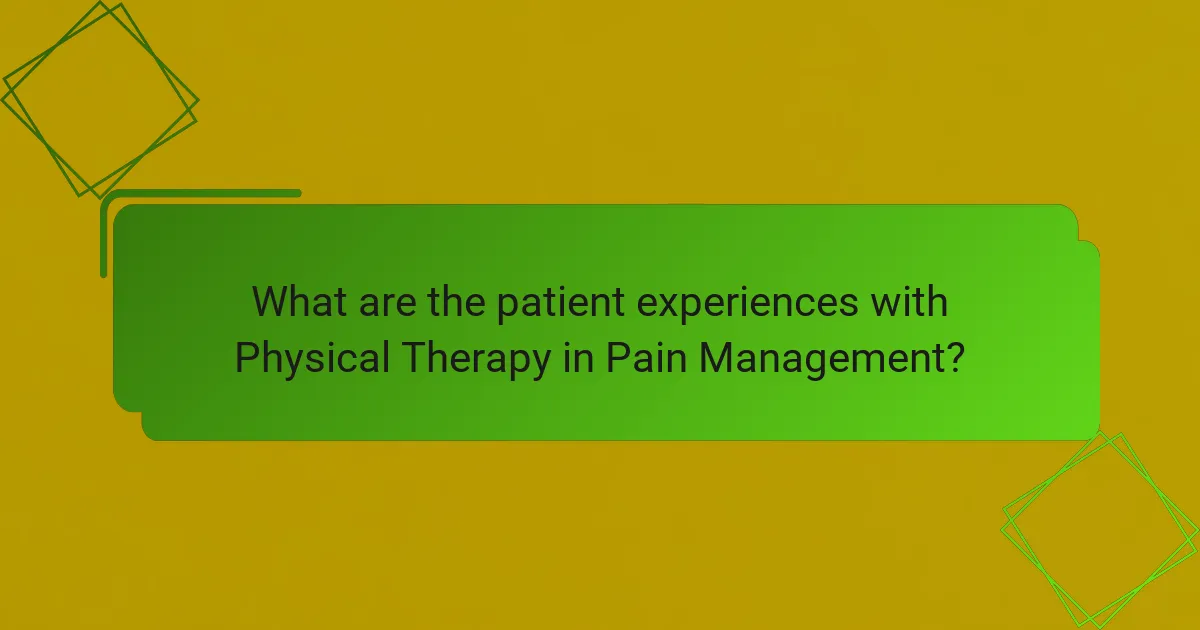
What is the Role of Physical Therapy in Pain Management?
Physical therapy plays a crucial role in pain management. It utilizes various techniques to alleviate pain and improve function. These techniques include exercise, manual therapy, and modalities such as heat and ice. Physical therapists assess patients to develop personalized treatment plans. They aim to reduce pain, enhance mobility, and promote recovery. Research indicates that physical therapy can significantly decrease chronic pain levels. A study published in the Journal of Orthopaedic & Sports Physical Therapy found that patients receiving physical therapy reported a 50% reduction in pain. This highlights the effectiveness of physical therapy in managing pain.
How does Physical Therapy contribute to Pain Management?
Physical therapy contributes to pain management by employing various techniques to alleviate discomfort. These techniques include manual therapy, exercise, and modalities like heat or cold therapy. Manual therapy involves hands-on techniques to manipulate soft tissues and joints, which can reduce pain and improve mobility. Exercise therapy focuses on strengthening muscles and enhancing flexibility, promoting long-term pain relief. Modalities such as ultrasound or electrical stimulation can target pain directly and facilitate healing. Research indicates that physical therapy can significantly reduce pain levels in patients with musculoskeletal issues. A study published in the Journal of Orthopaedic & Sports Physical Therapy found that patients receiving physical therapy reported a 50% reduction in pain after treatment. This evidence supports the effectiveness of physical therapy in managing pain.
What techniques are used in Physical Therapy for pain relief?
Physical therapy employs various techniques for pain relief. Common methods include manual therapy, which involves hands-on manipulation of tissues. Exercise therapy is another key technique, promoting strength and flexibility. Modalities such as heat, cold, ultrasound, and electrical stimulation are also frequently used. These modalities help reduce inflammation and improve circulation. Additionally, education on posture and body mechanics is vital for long-term pain management. Research indicates that these techniques can significantly enhance recovery and reduce pain levels. For instance, a study published in the Journal of Orthopaedic & Sports Physical Therapy found that patients receiving manual therapy reported greater pain relief compared to those who did not.
How does Physical Therapy differ from other pain management methods?
Physical therapy differs from other pain management methods by focusing on rehabilitation and functional improvement. It employs exercises, manual therapy, and modalities to alleviate pain. Unlike medication, which may mask symptoms, physical therapy addresses the root cause of pain. It enhances mobility and strength through tailored programs. Studies show that physical therapy can reduce the need for opioid medications in chronic pain cases. This approach promotes long-term recovery and self-management skills. In contrast, methods like injections or surgery are invasive and may involve longer recovery times. Physical therapy emphasizes patient education and active participation in their recovery process.
What are the key benefits of Physical Therapy in managing pain?
Physical therapy offers several key benefits in managing pain. It helps to reduce pain through targeted exercises and manual therapy techniques. These methods improve mobility and flexibility, which can alleviate discomfort. Physical therapy also strengthens muscles, providing support to affected areas and preventing future injuries. Additionally, it promotes proper body mechanics, reducing strain on joints and tissues. Evidence shows that physical therapy can decrease reliance on pain medications. A study published in the Journal of Orthopaedic & Sports Physical Therapy found that patients who underwent physical therapy reported significant pain relief. Overall, physical therapy is an effective approach to pain management that enhances overall function and quality of life.
How does Physical Therapy enhance mobility and function?
Physical therapy enhances mobility and function by improving strength, flexibility, and coordination. It utilizes targeted exercises to restore movement patterns. These exercises are tailored to individual needs and conditions. Physical therapists assess patients to design effective rehabilitation programs. They provide manual therapy techniques to alleviate pain and stiffness. Research shows that physical therapy can lead to significant functional improvements. A study published in the Journal of Physical Therapy Science found that patients experienced a 40% increase in mobility after six weeks of therapy. This evidence supports the effectiveness of physical therapy in enhancing overall physical function.
What psychological benefits can patients experience from Physical Therapy?
Patients can experience various psychological benefits from Physical Therapy. These benefits include reduced anxiety and depression levels. Engaging in physical activity can release endorphins, which improve mood. Additionally, patients often report increased self-efficacy and confidence. Achieving physical goals during therapy can enhance a sense of accomplishment. Social interaction with therapists and peers can also reduce feelings of isolation. Research indicates that physical therapy can lead to improved overall mental well-being. A study published in the Journal of Physical Therapy Science found that patients experienced significant reductions in psychological distress after completing therapy programs.

What techniques are commonly used in Physical Therapy for Pain Management?
Common techniques used in physical therapy for pain management include manual therapy, exercise therapy, and modalities such as heat and cold therapy. Manual therapy involves hands-on techniques to mobilize joints and soft tissues, which can alleviate pain and improve function. Exercise therapy focuses on strengthening, stretching, and improving mobility, helping patients regain function and reduce pain over time. Modalities like heat therapy can enhance blood flow and relax muscles, while cold therapy can reduce inflammation and numb pain. Research shows that a combination of these techniques can effectively manage pain and improve patient outcomes in various conditions.
How do manual therapy techniques work in Pain Management?
Manual therapy techniques work in pain management by manipulating muscles and joints to reduce pain and improve function. These techniques include mobilization, manipulation, and soft tissue techniques. Mobilization involves gentle movements to increase range of motion. Manipulation applies controlled force to joints, often resulting in immediate pain relief. Soft tissue techniques target muscle tension and trigger points to alleviate discomfort. Research shows that manual therapy can activate the body’s natural pain-relief mechanisms. For instance, a study published in the Journal of Orthopaedic & Sports Physical Therapy found that manual therapy significantly reduced pain in patients with musculoskeletal conditions.
What are the specific types of manual therapy used?
The specific types of manual therapy used include joint mobilization, soft tissue mobilization, and myofascial release. Joint mobilization involves the passive movement of joints to improve their function. Soft tissue mobilization focuses on manipulating muscles and fascia to relieve tension. Myofascial release targets the fascia to release restrictions and improve movement. These therapies are commonly used in physical therapy for pain management and rehabilitation. Studies show that these techniques can enhance recovery and reduce pain levels in patients.
How effective is manual therapy in reducing pain?
Manual therapy is effective in reducing pain. Studies indicate that manual therapy can significantly decrease pain levels in various conditions. For instance, a systematic review published in the Journal of Orthopaedic & Sports Physical Therapy found that manual therapy is beneficial for patients with musculoskeletal pain. The review highlighted that patients experienced improved pain relief and function after receiving manual therapy treatments. Furthermore, a meta-analysis in the Journal of Pain Research showed that manual therapy led to a moderate reduction in pain intensity. These findings support the effectiveness of manual therapy as a viable option for pain management.
What role does exercise play in Physical Therapy for Pain Management?
Exercise is a fundamental component of physical therapy for pain management. It helps to improve mobility and strength, which can alleviate pain symptoms. Regular exercise can enhance blood circulation, promoting healing in affected areas. Therapeutic exercises are tailored to individual needs, addressing specific pain sources. Research shows that exercise can reduce chronic pain by up to 30% in some patients. Additionally, exercise helps in the release of endorphins, natural pain relievers produced by the body. This approach not only reduces pain but also improves overall physical function. Therefore, exercise plays a crucial role in enhancing recovery and maintaining long-term pain relief in physical therapy.
What types of exercises are typically prescribed?
Typically prescribed exercises include stretching, strengthening, and aerobic activities. Stretching exercises improve flexibility and reduce muscle tension. Strengthening exercises enhance muscle strength and support joint stability. Aerobic activities, such as walking or cycling, improve cardiovascular endurance. These exercises are tailored to individual needs based on specific conditions. Research shows that exercise can significantly reduce pain and improve function in patients. A study by Goel et al. (2020) found that prescribed exercises lead to better outcomes in pain management.
How does exercise contribute to long-term pain relief?
Exercise contributes to long-term pain relief by improving physical function and reducing inflammation. Engaging in regular physical activity strengthens muscles and enhances flexibility. This leads to better support for joints, which can alleviate pain. Exercise also stimulates the release of endorphins, natural pain-relieving hormones. Research indicates that consistent exercise can lower chronic pain levels. A study published in the Journal of Pain Research found that aerobic exercise reduced pain in patients with fibromyalgia. Additionally, exercise promotes better sleep and mood, which can further reduce pain perception.

What are the patient experiences with Physical Therapy in Pain Management?
Patient experiences with physical therapy in pain management are generally positive. Many patients report significant pain relief after undergoing physical therapy. They often appreciate the personalized treatment plans tailored to their specific needs. Improved mobility and strength are common outcomes noted by patients.
Additionally, patients frequently mention the supportive environment created by physical therapists. This encouragement helps motivate them to adhere to their rehabilitation programs. Research indicates that approximately 80% of patients experience reduced pain levels after completing a physical therapy regimen.
Moreover, patients value the educational aspect of physical therapy. They gain insights into their conditions and learn effective self-management strategies. Overall, physical therapy is viewed as a crucial component in managing pain effectively.
How do patients perceive the effectiveness of Physical Therapy?
Patients generally perceive physical therapy as an effective treatment option for managing pain and improving function. Many report significant improvements in mobility and pain reduction after completing therapy sessions. A study published in the Journal of Physical Therapy Science found that 85% of patients experienced positive outcomes from their physical therapy interventions. Patients often appreciate the personalized care and hands-on techniques used by therapists. They value the education provided about their conditions and the strategies for self-management. Overall, satisfaction with physical therapy is high, with many patients recommending it for similar issues.
What common outcomes do patients report after Physical Therapy?
Patients commonly report improved mobility after Physical Therapy. Enhanced range of motion is frequently noted. Many experience reduced pain levels as a result of targeted treatment. Strength gains are also a common outcome. Patients often mention increased functionality in daily activities. Improved balance and coordination are reported as well. Enhanced quality of life is a significant benefit. These outcomes align with findings from various studies on Physical Therapy effectiveness.
How do patient demographics influence experiences with Physical Therapy?
Patient demographics significantly influence experiences with physical therapy. Factors such as age, gender, socioeconomic status, and cultural background shape individual perceptions and responses to treatment. Younger patients may have different recovery expectations compared to older patients. Gender can affect communication styles and comfort levels during therapy sessions. Socioeconomic status often determines access to resources, affecting treatment continuity. Cultural background influences health beliefs and attitudes toward therapy. Research shows that tailored approaches considering these demographics improve patient satisfaction and outcomes. For instance, a study published in the Journal of Physical Therapy Science found that culturally sensitive care enhances engagement and adherence among diverse populations.
What challenges do patients face during Physical Therapy?
Patients face several challenges during Physical Therapy. Pain management is a significant issue. Many patients experience discomfort during exercises. This can lead to reluctance in participating fully. Time constraints also pose a challenge. Patients often struggle to fit sessions into their schedules. Financial barriers can limit access to necessary treatments. Insurance coverage may not fully support the cost of therapy. Emotional and psychological factors also play a role. Anxiety about recovery can hinder progress. Lastly, communication with therapists can sometimes be inadequate. This may lead to misunderstandings about treatment plans.
What are common barriers to accessing Physical Therapy?
Common barriers to accessing physical therapy include financial constraints, lack of insurance coverage, and limited availability of services. Many patients cannot afford out-of-pocket expenses for therapy sessions. Insurance plans may not cover necessary treatments, leading to further financial strain. Geographic location can also limit access, particularly in rural areas where physical therapy clinics are scarce. Additionally, patients may face transportation difficulties, making it hard to attend appointments. Cultural perceptions and stigma around seeking help can deter individuals from pursuing therapy. Finally, long wait times for appointments can discourage patients from starting treatment. These barriers collectively hinder effective access to physical therapy services.
How can patients overcome these challenges to benefit from Physical Therapy?
Patients can overcome challenges to benefit from physical therapy by actively engaging in their treatment plans. Consistent attendance at scheduled sessions is crucial. Open communication with physical therapists helps address concerns and adjust techniques. Setting realistic goals can improve motivation and adherence. Patients should practice recommended exercises at home to reinforce progress. Seeking support from family and friends can enhance commitment to therapy. Maintaining a positive mindset aids in overcoming psychological barriers. Evidence shows that adherence to prescribed physical therapy leads to better outcomes in pain management.
What are some best practices for maximizing the benefits of Physical Therapy?
To maximize the benefits of Physical Therapy, patients should actively participate in their treatment plans. Engaging in prescribed exercises enhances recovery and strength. Consistency in attending scheduled sessions is crucial for progress. Communicating openly with the therapist about pain levels and concerns leads to tailored adjustments. Setting realistic goals helps track improvements effectively. Incorporating home exercises into daily routines reinforces therapy gains. Maintaining a positive mindset can improve motivation and outcomes. Following the therapist’s advice on lifestyle changes supports overall health and recovery.
How can patients actively participate in their Physical Therapy journey?
Patients can actively participate in their physical therapy journey by setting clear goals. They should communicate their specific needs and preferences with their therapist. Engaging in regular feedback during sessions helps tailor the treatment. Patients must adhere to prescribed exercises and home routines for optimal recovery. Keeping a journal of progress and challenges can enhance communication with the therapist. Research shows that patient involvement improves outcomes in physical therapy. A study published in the Journal of Orthopaedic & Sports Physical Therapy found that engaged patients experience faster recovery times. Active participation fosters a sense of ownership over the rehabilitation process.
What tips can enhance the overall experience and outcomes of Physical Therapy?
To enhance the overall experience and outcomes of physical therapy, patients should actively communicate with their therapists. Clear communication about pain levels and treatment preferences can lead to better-tailored sessions. Setting specific goals with the therapist can provide direction and motivation. Consistency in attending scheduled sessions is crucial for progress. Patients should also engage in prescribed exercises at home to reinforce gains made during therapy. Maintaining a positive mindset can significantly impact recovery. Educating oneself about the therapy process can alleviate anxiety and improve participation. Lastly, seeking support from family or friends can boost morale and accountability. These strategies collectively contribute to improved physical therapy outcomes.
The primary entity of this article is physical therapy, specifically its role in pain management. The article outlines various techniques employed in physical therapy, including manual therapy, exercise, and modalities such as heat and cold therapy, which are utilized to alleviate pain and improve function. It highlights the benefits of physical therapy, such as reduced pain levels, enhanced mobility, and improved psychological well-being, backed by research findings. Additionally, the article discusses patient experiences, common challenges faced during therapy, and best practices for maximizing treatment outcomes. Overall, it provides a comprehensive overview of how physical therapy serves as an effective approach to managing pain.